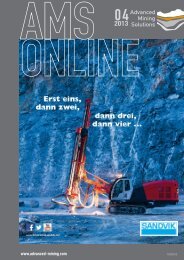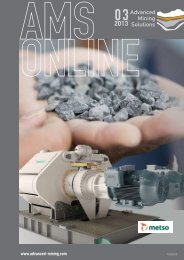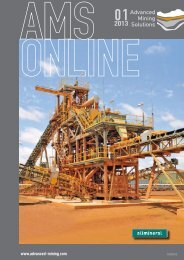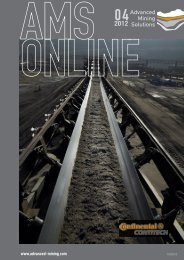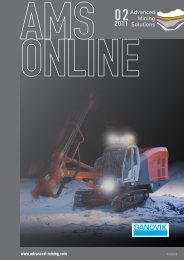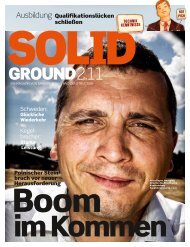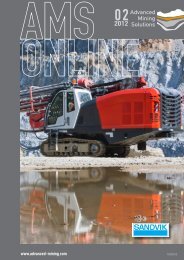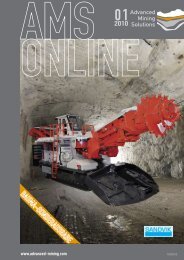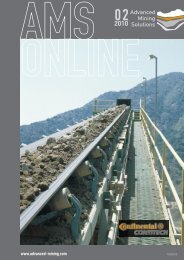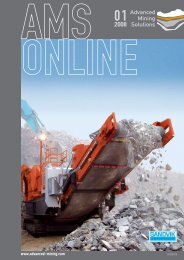A new face drilling rig for narrow tunnels and ... - Advanced Mining
A new face drilling rig for narrow tunnels and ... - Advanced Mining
A new face drilling rig for narrow tunnels and ... - Advanced Mining
You also want an ePaper? Increase the reach of your titles
YUMPU automatically turns print PDFs into web optimized ePapers that Google loves.
Going underground<br />
Experts have been predicting <strong>for</strong> years that the nonmetallic<br />
minerals industry would go underground. A few<br />
pits did take this step, usually <strong>for</strong> environmental reasons,<br />
i.e. to reduce the dust <strong>and</strong> noise nuisance <strong>for</strong> the local<br />
residents. This included our client Märker Kalk GmbH,<br />
whose resources at the Herrlingen quarry in Baden-<br />
Wuerttemberg were nearing exhaustion.<br />
There was no prospect of obtaining yet another approval<br />
<strong>for</strong> sur<strong>face</strong> quarrying close to a residential district. The<br />
logical move was to consider using underground mining<br />
methods <strong>and</strong> as a result the Mähringer Berg project was<br />
put into action.<br />
Planning considerations<br />
Planning considerations were based market conditions<br />
<strong>and</strong> the geology of the deposits ‘All is dark ahead of the<br />
pick’- this old mining saying had twofold significance when<br />
it came to the Märker project:<br />
It applied firstly to the client’s general project <strong>for</strong><br />
developing the underground workings <strong>and</strong> building a<br />
<strong>new</strong> kiln to process the high-grade white lime. This first<br />
required a lengthy planning <strong>and</strong> clarification process that<br />
included financing arrangements, technical equipment,<br />
licences <strong>and</strong> partners. All these procedures were carried<br />
out against a background of increasing dem<strong>and</strong> <strong>for</strong> the end<br />
product. But now that every - thing is ready <strong>for</strong> ‘harvesting’<br />
the market appears to be much less favourable. The global<br />
economic crisis, which has been accompanied by a fall in<br />
dem<strong>and</strong>, has left its traces. Nevertheless, as soon as the<br />
markets recover this long-term investment project will be<br />
delivering the expected returns.<br />
And secondly to the geology in the strict sense of the<br />
word. In 2001 an exploration roadway was driven <strong>and</strong> a<br />
small-scale test extraction undertaken. And the geology, it<br />
has to be said, was perfect.<br />
However, after the contract to develop the Mähringer<br />
Berg deposits was awarded in June 2007 to the Mähringer<br />
Berg joint venture, comprising Schachtbau Nordhausen<br />
GmbH <strong>and</strong> Thyssen Schachtbau GmbH, it was found that<br />
the geological conditions encountered along the 1,350 m<br />
of drivage differed somewhat from the o<strong>rig</strong>inal predictions<br />
<strong>and</strong> findings.<br />
Rockbolts, weldmesh panels <strong>and</strong> shotcrete had to be<br />
employed on a large scale in the long-term excavations<br />
Issue 04 | 2010<br />
TRANSFER OF TECHNOLOGY<br />
<strong>and</strong> roadways. However it is hoped that the poor geology<br />
encountered in some of the roadway developments will not<br />
be repeated to the same extent in the excavations made to<br />
the north of the same extraction zone.<br />
The ‘Mähringer Berg deposits’<br />
development project<br />
Excavation work on the conveyor road, parallel headings,<br />
crosscuts <strong>and</strong> rooms <strong>for</strong> the crusher, trans<strong>for</strong>mer <strong>and</strong> mine<br />
fan began on 09.09.2007. The highly karstified strata called<br />
<strong>for</strong> the highest safety st<strong>and</strong>ards <strong>and</strong> required a lot more<br />
support than had been planned. Roadways with profiles of<br />
32 to 36 m 2 would have to serve as the main production<br />
arteries <strong>for</strong> decades to come. The crusher room, <strong>for</strong><br />
example, was not spot-bolted but instead supported by a<br />
30 cm-thick coating of shotcrete, two layers of weldmesh<br />
<strong>and</strong> rockbolts up to 5 m in length. After each round of<br />
shots the heading team had to reassess the condition of<br />
the strata <strong>and</strong> determine in collaboration with client the<br />
most appropriate measures to be used <strong>for</strong> support <strong>and</strong><br />
rein<strong>for</strong>cement.<br />
In order not to contaminate the high-quality lime<br />
shotcreting was only permitted in the cut-through road.<br />
More than 3,000 tonnes of this material were eventually<br />
used in all the infrastructure cavities.<br />
The increased safety measures, additional length of<br />
drivages required <strong>for</strong> the parallel heading <strong>and</strong> crosscuts<br />
<strong>and</strong> the need <strong>for</strong> additional ripping at the roof <strong>and</strong> ancillary<br />
support work all combined to delay the completion of the<br />
project by nearly half a year.<br />
The development work was completed at the end<br />
of 2008. A total of 1,350 m of roadways <strong>and</strong> some<br />
49,000 m 3 of cavities had been excavated at an average pull<br />
of 3.14 m <strong>and</strong> with an explosives consumption rate of about<br />
1.7 kg/m 3 . Each complete pull took 18.5 hours to execute,<br />
including time <strong>for</strong> ancillary operations <strong>and</strong> unscheduled<br />
support <strong>and</strong> rein<strong>for</strong>cement work.<br />
The shotfiring pattern, length of pull <strong>and</strong> choice of<br />
explosive all had to be coordinated so as to maximise the<br />
heading per<strong>for</strong>mance, reduce the degradation rate <strong>and</strong><br />
keep the proportion of debris less than 20 mm in size below<br />
35 %. Of course this could not always be achieved in those<br />
karst joints that were filled with loam <strong>and</strong> silt. An upper<br />
limit had also been placed on the vibration levels due to<br />
blasting, with no firing permitted at all between ten in the<br />
evening <strong>and</strong> six in the morning.<br />
www.advanced-mining.com<br />
29



